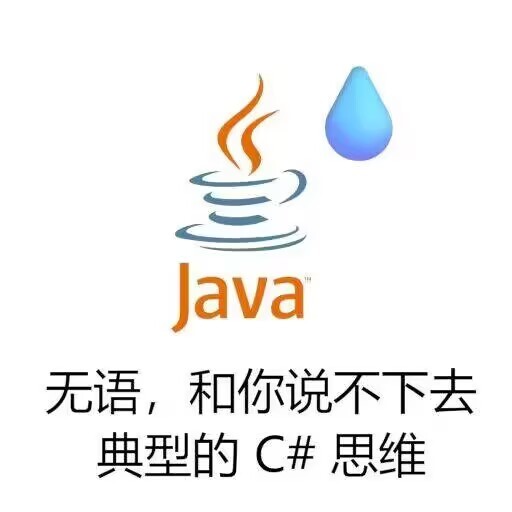笔记较为简单,主要记录了一些Java与C#某些地方的相似与区别,适合简单浏览速通,不细致不深入。

基础
常量
数据类型
在Java中,整数类型包括以下几个:
| 类型 | 大小 | 范围 |
|---|
| byte 字节型 | 8个bit,也就是1个字节 | -128~+127 |
| short 短整形 | 16个bit,也就是2个字节 | -32768~+32767 |
| int 整形 | 32个bit,也就是4个字节 | -2147483648 ~ +2147483647 |
| long 长整形(+L/l) | 64个bit,也就是8个字节 | 9223372036854775808 ~ +9223372036854775807 |
| float 单精度浮点型(+F/f) | 32个bit,也就是4个字节 | |
| double 双精度浮点型 | 64个bit,也就是8个字节 | |
| char 字符型 | 16个bit,也就是2字节,它不带符号 | 0 ~ 65535 |
| boolen 布尔类型 | | true,false |
隐式类型转换:小转大,大不转小
强转与C一样:(数据类型)变量
字符串支持“+”拼接
面向对象
重载
相同名称的方法可以定义多次,传入不同类型的参数和返回类型,在使用时会自动匹配
1
2
3
4
5
6
7
8
9
10
11
12
13
14
| public int sum(int a, int b)
{
return a + b;
}
public double sum(double a, double b)
{
return a + b;
}
public String sum(String a, String b)
{
return a + b;
}
|
1
2
| XX.sum(1.5, 2.2);
XX.sum(6, 9);
|
构造方法
1
2
3
4
5
6
7
8
9
10
11
12
| public class Person {
String name;
int age;
String sex;
Person(){
name = "小明";
age = 18;
sex = "男";
}
}
|
构造方法可以重构:
1
2
3
4
5
6
7
8
9
10
11
12
13
14
15
| public class Person {
String name;
int age;
String sex;
Person(String name, int age, String sex){
this.name = name;
this.age = age;
this.sex = sex;
}
Person(){
name = "小明";
}
}
|
构造方法会在new的时候自动执行:
1
2
3
4
5
| public static void main(String[] args) {
Person p = new Person();
Person h = new Person("小红", 15, "女");
System.out.println(p.name);
}
|
静态变量和静态方法
一旦被声明为静态,那么通过这个类创建的所有对象,操作的都是同一个目标,也就是说,对象再多,也只有这一个静态的变量或方法。一个对象改变了静态变量的值,那么其他的对象读取的就是被改变的值。在静态方法中,无法获取成员变量的值,但是静态方法可以访问到静态变量。
1
2
3
4
5
6
| public class Person {
String name;
int age;
String sex;
static String info;
}
|
包 = namespace
packa,import
访问权限
| 当前类 | 同一个包下的类 | 不同包下的子类 | 不同包下的类 |
|---|
| public | ✅ | ✅ | ✅ | ✅ |
| protected | ✅ | ✅ | ✅ | ❌ |
| 默认 | ✅ | ✅ | ❌ | ❌ |
| private | ✅ | ❌ | ❌ | ❌ |
继承:extends
(如果父类没有使用默认构造函数,子类需要调用super父类构造方法(super代表这个子类的父类))
1
2
3
4
5
6
7
8
9
| public class Student extends Person{
public Student(String name, int age, String sex) {
super(name, age, sex, "学生");
}
public void study(){
System.out.println("我的名字是 "+name+",我在学习!");
}
}
|
判断一个对象是什么类:
1
2
3
4
5
6
7
8
9
| public static void main(String[] args) {
Person person = new Student("小明", 18, "男");
if(person instanceof Student) {
System.out.println("对象是 Student 类型的");
}
if(person instanceof Person) {
System.out.println("对象是 Person 类型的");
}
}
|
重写
注意,方法的重写不同于之前的方法重载,不要搞混了,方法的重载是为某个方法提供更多种类,而方法的重写是覆盖原有的方法实现,比如我们现在不希望使用Object类中提供的equals方法,那么我们就可以将其重写了:
1
2
3
4
5
6
7
8
9
10
11
12
13
14
15
| public class Person{
...
@Override
public boolean equals(Object obj) {
if(obj == null) return false;
if(obj instanceof Person) {
Person person = (Person) obj;
return this.name.equals(person.name) &&
this.age == person.age &&
this.sex.equals(person.sex);
}
return false;
}
}
|
抽象类
1
2
3
4
5
6
7
8
9
10
11
12
13
14
15
| public abstract class Person {
protected String name;
protected int age;
protected String sex;
protected String profession;
protected Person(String name, int age, String sex, String profession) {
this.name = name;
this.age = age;
this.sex = sex;
this.profession = profession;
}
public abstract void exam();
}
|
抽象类的子类必须要实现抽象类中所有抽象方法,除非抽象类的子类也是抽象类。
抽象类无法直接实例化。
接口
interface定义接口
1
2
3
| public interface Study {
void study();
}
|
implements实现接口
1
2
3
4
5
6
7
8
9
10
| public class Student extends Person implements Study {
public Student(String name, int age, String sex) {
super(name, age, sex, "学生");
}
@Override
public void study() {
System.out.println("我会学习!");
}
}
|
接口可以多继承
接口可以设置默认实现:
1
2
3
4
5
6
7
| public interface Study {
void study();
default void test() {
System.out.println("我是默认实现");
}
}
|
接口可以继承自其他接口
枚举
枚举类也可以添加成员方法
1
2
3
4
5
6
7
8
9
10
11
12
| public enum Status {
RUNNING("睡觉"), STUDY("学习"), SLEEP("睡觉");
private final String name;
Status(String name){
this.name = name;
}
public String getName() {
return name;
}
}
|
包装类与特殊包装类
BigInteger , 超大整数类型,没有限制
1
2
3
4
| public static void main(String[] args) {
BigInteger i = BigInteger.valueOf(Long.MAX_VALUE);
System.out.println(i);
}
|
BigDecimal , 更高精度浮点
1
2
3
4
5
6
7
| public static void main(String[] args) {
BigDecimal i = BigDecimal.valueOf(10);
i = i.divide(BigDecimal.valueOf(3), 100, RoundingMode.CEILING);
System.out.println(i);
}
|
可变长参数
定义函数参数时加三个‘.’
1
2
3
4
5
6
7
8
9
| public class Person {
String name;
int age;
String sex;
public void test(String... strings){
}
}
|
在使用时可以传任意数量的实参
1
2
3
4
| public static void main(String[] args) {
Person person = new Person();
person.test("1!", "5!", "哥们在这跟你说唱");
}
|
使用时strings为数组
String
如果我们仅仅是想要判断两个字符串的内容是否相同,不要使用==,String类重载了equals方法用于判断和比较内容是否相同:
1
2
3
4
5
| public static void main(String[] args) {
String str1 = new String("Hello World");
String str2 = new String("Hello World");
System.out.println(str1.equals(str2));
}
|
StringBuilder
这个类型是专门用于构造字符串的,我们可以使用它来对字符串进行拼接、裁剪等操作,它就像一个字符串编辑器,弥补了字符串不能修改的不足:
1
2
3
4
5
6
| public static void main(String[] args) {
StringBuilder builder = new StringBuilder();
builder.append("AAA");
builder.append("BBB");
System.out.println(builder.toString());
}
|
StringBuilder类的编辑操作也非常多,这里就不一一列出了。
泛型
泛型类
1
2
3
4
5
6
7
8
9
10
11
12
| public class Score<T> {
String name;
String id;
T value;
public Score(String name, String id, T value) {
this.name = name;
this.id = id;
this.value = value;
}
}
|
如果要让某个变量支持引用确定了任意类型的泛型,那么可以使用 ? 通配符:
1
2
3
4
5
6
| public static void main(String[] args) {
Test<?> test = new Test<Integer>();
test = new Test<String>();
Object o = test.value;
}
|
泛型只能确定为一个引用类型,基本类型是不支持的
泛型方法
1
2
3
4
5
6
7
8
9
| public class Main {
public static void main(String[] args) {
String str = test("Hello World!");
}
private static <T> T test(T t){
return t;
}
}
|
泛型约束
1
2
3
4
5
6
7
8
9
10
11
12
13
14
| public class Score<T extends Number> {
private final String name;
private final String id;
private final T value;
public Score(String name, String id, T value) {
this.name = name;
this.id = id;
this.value = value;
}
public T getValue() {
return value;
}
|
缓冲字节流:
BufferedInputStream:
要创建一个缓冲字节流,只需要将原本的流作为构造参数传入BufferedInputStream即可:
1
2
3
4
5
6
7
8
| public static void main(String[] args) {
try (BufferedInputStream bufferedInputStream = new BufferedInputStream(new FileInputStream("test.txt"))){
System.out.println((char) bufferedInputStream.read());
}catch (IOException e){
e.printStackTrace();
}
}
|
BufferedInputStream操作和原来的FileInputStream流是一样的
1
2
3
4
5
6
7
8
| public static void main(String[] args) {
try (BufferedOutputStream outputStream = new BufferedOutputStream(new FileOutputStream("output.txt"))){
outputStream.write("lbwnb".getBytes());
outputStream.flush();
}catch (IOException e) {
e.printStackTrace();
}
}
|
多线程
多线程的实现方式:
继承Thread类:
1
2
3
4
5
6
7
8
9
10
11
12
13
14
15
16
17
18
19
20
21
22
23
24
25
26
27
28
29
30
31
32
33
34
35
36
37
38
39
40
41
42
43
44
45
46
47
|
public class Demo01 {
public static void main(String[] args) {
MyThread t01 = new MyThread();
MyThread t02 = new MyThread();
MyThread t03 = new MyThread("线程03");
t01.run();
t02.run();
t03.run();
t01.start();
t02.start();
t03.start();
t01.setName("线程01");
t02.setName("线程02");
Thread.currentThread().setName("主线程");
for (int i = 0; i < 50; i++) {
System.out.println(Thread.currentThread().getName() + ":" + i);
}
}
}
class MyThread extends Thread{
public MyThread() {
}
public MyThread(String name) {
super(name);
}
@Override
public void run() {
for (int i = 0; i < 50; i++) {
System.out.println(this.getName() + ":" + i);
}
}
}
|
实现Runnable接口:
1
2
3
4
5
6
7
8
9
10
11
12
13
14
15
16
17
18
19
20
21
22
23
24
25
26
27
28
29
30
31
32
33
|
public class Demo02 {
public static void main(String[] args) {
MyRunnable myRun = new MyRunnable();
Thread t01 = new Thread(myRun, "线程01");
Thread t02 = new Thread(myRun, "线程02");
Thread t03 = new Thread(myRun, "线程03");
t01.start();
t02.start();
t03.start();
new Thread(new Runnable() {
@Override
public void run() {
for (int i = 0; i < 20; i++) {
System.out.println(Thread.currentThread().getName() + " - " + i);
}
}
},"线程04").start();
}
}
class MyRunnable implements Runnable{
@Override
public void run() {
for (int i = 0; i < 50; i++) {
System.out.println(Thread.currentThread().getName() + " - " + i);
}
}
|
线程锁和线程同步
synchronized关键字也可以作用于方法上,调用此方法时也会获取锁:
1
2
3
4
5
6
7
8
9
10
11
12
13
14
15
16
17
18
19
20
| private static int value = 0;
private static synchronized void add(){
value++;
}
public static void main(String[] args) throws InterruptedException {
Thread t1 = new Thread(() -> {
for (int i = 0; i < 10000; i++) add();
System.out.println("线程1完成");
});
Thread t2 = new Thread(() -> {
for (int i = 0; i < 10000; i++) add();
System.out.println("线程2完成");
});
t1.start();
t2.start();
Thread.sleep(1000);
System.out.println(value);
}
|
注解 = 特性
1
2
3
4
| @Target({ElementType.METHOD, ElementType.TYPE}) @Retention(RetentionPolicy.RUNTIME)
public @interface Test {
String value();
}
|
—end—





